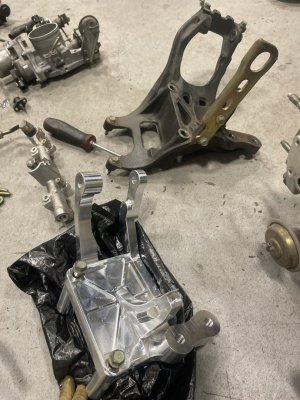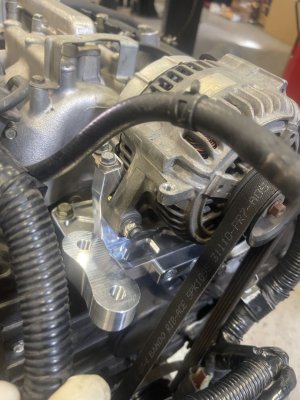Starting to gather parts for a 3.2 build and noticed the Foundry bracket. Haven't yet gotten an email response and their site initially showed it was not available, but it now shows the ability to order so it may be available. Based on an old thread about smaller lighter alternators, i don't want to go there. Anyone know if it uses the OE alt? Any failures in the wind? I almost had a hernia lifting that OE boat anchor bracket. I emailed SOS and they said they did not have the lighter bracket, but offered to sell me an OE bracket-he-he. You could crash an NSX into a Tank at 100 mph and that bracket would not be damaged. Cautiously excited for further weight savings. Thanks!
-
Protip: Profile posts are public! Use Conversations to message other members privately. Everyone can see the content of a profile post.
You are using an out of date browser. It may not display this or other websites correctly.
You should upgrade or use an alternative browser.
You should upgrade or use an alternative browser.
FOUNDRY 3 ALUMINUM ALTERNATOR BRACKETS
- Thread starter TANTO
- Start date
I'd steer clear. The OEM bracket is steel for a reason. It's a structural piece that bears the majority of the engine weight and load. Have you ever noticed that the bracket and that particular engine mount are made of steel, but all the other ones are aluminum? That's on purpose. On the NSX, the front and rear mounts are aluminum and connect to the aluminum cross-beams of the subframe. The left mount is aluminum and connects to a bracket that is directly welded to the body. If you look at the transaxle, there is a significantly greater weight on the right side because of the engine block. It's hundreds of pounds heavier compared to the left side. So, you have a steel bracket connecting to a steel mount and connecting directly to the body.Starting to gather parts for a 3.2 build and noticed the Foundry bracket. Haven't yet gotten an email response and their site initially showed it was not available, but it now shows the ability to order so it may be available. Based on an old thread about smaller lighter alternators, i don't want to go there. Anyone know if it uses the OE alt? Any failures in the wind? I almost had a hernia lifting that OE boat anchor bracket. I emailed SOS and they said they did not have the lighter bracket, but offered to sell me an OE bracket-he-he. You could crash an NSX into a Tank at 100 mph and that bracket would not be damaged. Cautiously excited for further weight savings. Thanks!
Think of it this way- Honda's team were tasked with using aluminum wherever they could on the car. They were able to use it on three of the four engine mounts, but despite all the testing and resources available to them, they couldn't find a way to make it work on the right side. Rather than a complete structural failure, I suspect the aluminum bracket permitted more flex than they were prepared to accept.
I've had that bracket (and the engine mounts from the same source) for about 2 years now and zero issue despite tracking the car and very spirited driving, and bumpy roads full of pot holes. You still use the OEM alternator.
I should say that i have not actually pulled an NSX engine yet, but from the manual pic's there are 4 motor mounts that likely take all the vertical load and "should" take the side load as well. But i'll not question Shigeru for providing an added "side" mount to keep our monster from jumping out of the engine bay he-he. That side mount bolts to the bracket of interest. While a certainly applaud F3 for their efforts, i'm seeing a major design issue. The OE bracket has 4 mounting bolts and the F3 dropped the two mounts under the TB (!). So if the two remaining bolts were to loosen just a tad this bracket will "twist" in the horizontal. I can see how this may well work in practice as it will use that side engine mount for stabilization. However that side bracket was there to ADD side stabilization and takes it away and totally defeats Honda's purpose for that side mount. Second i don't like that this mount sits atop of two "spacers". IMO they could be larger and welded on to the mount plate. Bottom line for me is those two mounts under the TB are absolutely necessary for a "perfect" design. They could likely add a bolt-on piece to catch those two bolts. In addition i don't see why they wouldn't have a brace between the two alternator uprights also. I'm worried that the lateral(sideways) load on them will bend them a bit more than desired. Aluminum is very bendy (i once saw a guy at Mid-Ohio race track laying on his hood with his girl friend!! How dare he? I will email F3 my thoughts. For the poster than is just installing one that i just rained on, i would use a lot of blue loctite and up the OE torque numbers say 10-12 foot lbs or might even consider using red loctite (eek) and for sure re-torque them after some hot use. Personally i may buy one and beef it up or just trim a few oz's off the OE mount as my gut still says this thing is way overdesigned as casts parts often are. A fabricated steel mount would likely drop the weight in half also, but cost and quality control make cast the pick for OE's. I see F3 works Titanium -wooo - i'm getting excited again.
I get what you’re saying just eyeballing it, but trust me when I tell you this bracket is actually quite beefy. Yeah it does get rid of the 2 m8 bolts that go under the intake manifold, but I’m not worried about that at all. For your concern about the alternator flexing the posts with side load from what I’m assuming you mean is from the belt tension, I wouldn’t worry about that either, the post in the middle of the bracket fits into a slot so it’s very solid, and the front has 2 steel dowel pins to line it up as well. The reason the m10 bolts have that doweled spacer thing is because of cost, this thing would probably cost a fortune more to make if the bracket and spacer were made from one giant piece of billet. I mean to each his own though, if it’s concerning you enough you don’t wanna run it then don’t run it, but you aren’t raining on my parade at all, I’m leaving it on my car.
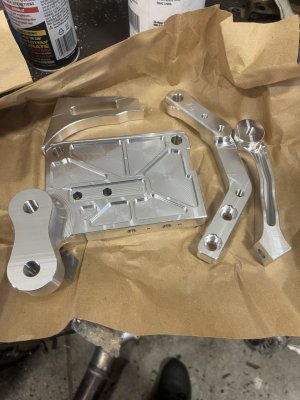
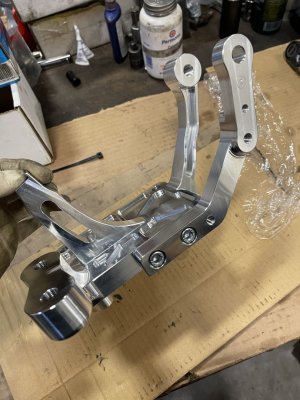
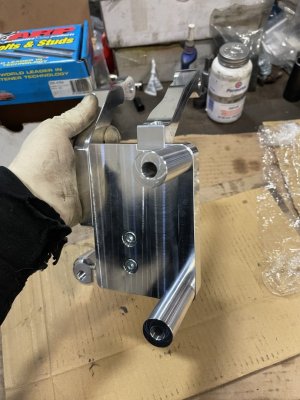



It's CNC'ed billet alu which is much stronger than cast parts. It would make zero sense for the OEM to do this due to insane costs & labor as opposed to a cast, large series produced part that's why Honda went with a recycled Accord/Legend bracket. I get the NSX chassis had a large amount of bespoke process to fabricate but from what I can remember this was an afterthought like the last minute shoe-horned VTEC heads inducing the slight rearwards tilt for the whole engine. Would have been suicidal from a running costs + project management point of view to add a CNC'ed bespoke part like this - also all alu parts on the NSX are either cast, stamped or extruded.this bracket is actually quite beefy
"Billet" simply means they cut it from a whole piece of aluminum (which they always do), likely a 6000 series and not expensive at all. It's not a type of material. Some "billet" parts used a stronger than average grade of aluminum, but the difference between a high and low strength aluminum is small. This billet word baffled the entire US street rod community for decades. While half of most airplanes use this material so it's no slouch, it is a fairly soft bendy material roughly half of the strength of say our "forged" suspension a-arms. Whether steel or aluminum, forged rules, but not warranted on a bracket like this. Billet is not much if any stronger than cast depending on the cast process. Aluminum is great for non-critical parts, but can never compare to steel or iron. As there are only two bolts on this piece, it is a less than perfect design based on my based on my lifetime(retired) of parts design/engineering. But again unless the part is on a Boeing Jet he-he, it doesn't have to be a 100% perfect design (or i would likely have not made it to retirement). I look forward to comments from the ex-nsx racers on their experience with this product and of course wish the best to us all. Overall i think it very unlikely to result in a failure under normal usage.
FWIW they use higher grade materials to start with. Also a fully CNC'ed part from billet is always structurally superior to cast, due to metallurgy: cast metal has a lower elasticity modulus, and will bend/break sooner. So yes you can then forge cast parts in order to get a thermodynamic reflow but then the cost is much, much higher so in our case it was limited to a few select critical parts (suspension arms, connecting rods..).
Like I said quite a few of us have this bracket, I used it on track, mountain roads, horribly bumpy streets around here with sidewalk-grade speed bumps, went to German autobahn for a 300kph blast... Foundry3 have it on their turbo NSX which would have a lot more torque, and no problem either.
Like I said quite a few of us have this bracket, I used it on track, mountain roads, horribly bumpy streets around here with sidewalk-grade speed bumps, went to German autobahn for a 300kph blast... Foundry3 have it on their turbo NSX which would have a lot more torque, and no problem either.
I stand behind my all comments above, BUT i just ordered this bracket. I will fabricate a new "under" mount to replace the uprights and catch the other OE bolts just to make this a 100% design IN MY OPINION. Even without my mod,s the side mount will almost certainly keep this bracket from "twisting" so an outright failure is extremely unlikely and thus Zoom and i assume others positive experiences. Just trying to use my education and experience of over half a decade to HELP us all drop weight safely while still maintaining Honda's OE safety factors. In my years i've seen a LOT of aftermarket products fail, it's just the nature of the beast so to speak. I'll post my mod later FWIW.
Similar threads
- Replies
- 1
- Views
- 2K
- Replies
- 40
- Views
- 29K
- Replies
- 0
- Views
- 5K
- Replies
- 97
- Views
- 43K







